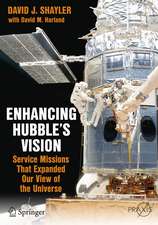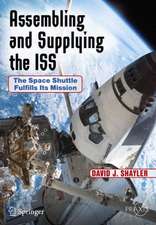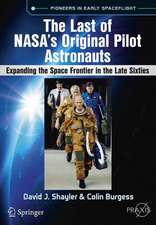Gemini Flies!: Unmanned Flights and the First Manned Mission: Springer Praxis Books
Autor David J. Shayleren Limba Engleză Paperback – 6 apr 2018
- The short unmanned orbital flight of Gemini 1 that tested the compatibility of launch vehicle, spacecraft and ground systems.
- The unmanned suborbital flight of Gemini 2 to establish the integrity of the reentry system and protective heat shield.
- The three-orbit manned evaluation flight of Gemini 3, christened ‘Molly Brown’ by her crew. A mission recalled orbit by orbit, using mission transcripts, post-flight reports and the astronauts’ own account of their historic journey.
The missions of Project Gemini was the pivotal steppingstone between Project Mercury and the Apollo Program. Following the success of its first two unmanned missions and the exploits of Gus Grissom and John Young on Gemini 3, NASA gained the confidence to plan an even bolder step on its next mission, as described in the next book in this series on Gemini 4.
Din seria Springer Praxis Books
-
 Preț: 294.46 lei
Preț: 294.46 lei -
 Preț: 223.45 lei
Preț: 223.45 lei -
 Preț: 193.12 lei
Preț: 193.12 lei -
 Preț: 167.85 lei
Preț: 167.85 lei -
 Preț: 288.98 lei
Preț: 288.98 lei -
 Preț: 323.74 lei
Preț: 323.74 lei -
 Preț: 401.38 lei
Preț: 401.38 lei -
 Preț: 264.12 lei
Preț: 264.12 lei - 8%
 Preț: 513.00 lei
Preț: 513.00 lei -
 Preț: 190.01 lei
Preț: 190.01 lei -
 Preț: 218.16 lei
Preț: 218.16 lei -
 Preț: 312.06 lei
Preț: 312.06 lei - 17%
 Preț: 414.04 lei
Preț: 414.04 lei -
 Preț: 216.41 lei
Preț: 216.41 lei -
 Preț: 262.27 lei
Preț: 262.27 lei -
 Preț: 264.35 lei
Preț: 264.35 lei -
 Preț: 167.63 lei
Preț: 167.63 lei -
 Preț: 284.81 lei
Preț: 284.81 lei -
 Preț: 259.08 lei
Preț: 259.08 lei -
 Preț: 305.47 lei
Preț: 305.47 lei -
 Preț: 244.14 lei
Preț: 244.14 lei -
 Preț: 227.85 lei
Preț: 227.85 lei -
 Preț: 285.25 lei
Preț: 285.25 lei -
 Preț: 295.56 lei
Preț: 295.56 lei -
 Preț: 357.17 lei
Preț: 357.17 lei -
 Preț: 275.79 lei
Preț: 275.79 lei -
 Preț: 257.08 lei
Preț: 257.08 lei -
 Preț: 349.71 lei
Preț: 349.71 lei -
 Preț: 272.45 lei
Preț: 272.45 lei -
 Preț: 270.27 lei
Preț: 270.27 lei - 8%
 Preț: 456.51 lei
Preț: 456.51 lei -
 Preț: 352.34 lei
Preț: 352.34 lei - 8%
 Preț: 394.80 lei
Preț: 394.80 lei -
 Preț: 320.65 lei
Preț: 320.65 lei -
 Preț: 325.29 lei
Preț: 325.29 lei -
 Preț: 253.11 lei
Preț: 253.11 lei -
 Preț: 192.86 lei
Preț: 192.86 lei -
 Preț: 313.40 lei
Preț: 313.40 lei -
 Preț: 150.51 lei
Preț: 150.51 lei -
 Preț: 233.34 lei
Preț: 233.34 lei -
 Preț: 286.78 lei
Preț: 286.78 lei -
 Preț: 212.01 lei
Preț: 212.01 lei -
 Preț: 366.83 lei
Preț: 366.83 lei -
 Preț: 299.99 lei
Preț: 299.99 lei -
 Preț: 232.27 lei
Preț: 232.27 lei -
 Preț: 284.58 lei
Preț: 284.58 lei -
 Preț: 212.45 lei
Preț: 212.45 lei -
 Preț: 159.81 lei
Preț: 159.81 lei -
 Preț: 349.48 lei
Preț: 349.48 lei - 20%
 Preț: 2061.61 lei
Preț: 2061.61 lei
Preț: 329.20 lei
Nou
Puncte Express: 494
Preț estimativ în valută:
62.99€ • 65.77$ • 52.13£
62.99€ • 65.77$ • 52.13£
Carte tipărită la comandă
Livrare economică 01-07 aprilie
Preluare comenzi: 021 569.72.76
Specificații
ISBN-13: 9783319681412
ISBN-10: 3319681419
Pagini: 290
Ilustrații: XXV, 333 p. 103 illus., 43 illus. in color.
Dimensiuni: 168 x 240 x 19 mm
Greutate: 0.68 kg
Ediția:1st ed. 2018
Editura: Springer International Publishing
Colecția Springer
Seriile Springer Praxis Books, Space Exploration
Locul publicării:Cham, Switzerland
ISBN-10: 3319681419
Pagini: 290
Ilustrații: XXV, 333 p. 103 illus., 43 illus. in color.
Dimensiuni: 168 x 240 x 19 mm
Greutate: 0.68 kg
Ediția:1st ed. 2018
Editura: Springer International Publishing
Colecția Springer
Seriile Springer Praxis Books, Space Exploration
Locul publicării:Cham, Switzerland
Cuprins
Author's Preface.- Acknowledgements.- Dedication.- Foreword by Colin Burgess.- Abbreviations and Acronyms.- Prologue: Molly Brown is on her way.- Chapter 1: Mercury Mark II.- Chapter 2: A "Clean and Green" Flying Machine.- Chapter 3: Ramming the Atmosphere.- Chapter 4: Preparations.- Chapter 5: Guts and John.- Chapter 6: All Systems Look Go.- Chapter 7: Molly Brown "Performing Nicely".- Chapter 8: Got Your Seat Belts Hooked?.- Chapter 9: The Unsinkable Molly Brown. Chapter 10: Gemini Operational.- Appendix I.- Appendix II.- Appendix III.- Bibliography.- About the author.- Other works by the author.- Index.
Recenzii
“Project Gemini (1964–66) was an important step in successfully landing humans on the moon. … This book covers the first two unmanned flights in the Gemini project as well its human mission (Gemini 3) completed in 1965. … Photographs and several appendices support the text. Space enthusiasts and those interested in the history of human spaceflight will enjoy this book.” (J. Z. Kiss, Choice, Vol. 56 (03), November, 2018)
Notă biografică
Dave Shayler's interest in the U.S. Gemini program began during the late 1960s while reading about the earlier missions of Apollo astronauts as they prepared for the first lunar landings. The skills they acquired, which secured their seats on Apollo, were achieved during ten Gemini missions flown between March 1965 and November 1966. From that early research, Dave learned that Gemini was an important steppingstone to Apollo, and though short, it was a critical program not only as preparation for going to the Moon but also in planning future programs. Even today, nearly 50 years after the final Gemini spacecraft flew, the program holds a special place in the hearts of those who worked on it.
Over the years this research continued and resulted in visits to the NASA JSC facilities and archives in Houston and the NARA records offices in Fort Worth, Texas, where many of the official Gemini documents had been retired. Dave had the good fortune to meet and interview astronauts andengineers who worked on the program and access retired documentation from that exciting era.
In 1976, as his interest in human spaceflight developed, he joined the British Interplanetary Society; in 1984 Dave was elected a Fellow and since 2013 has served as a member of the BIS Council. For the past few years, he has served as Chair for the BIS Library Committee and Coordinator and Co-Chair of the annual Soviet/Chinese Technical Forum. In addition in 1990, he became a co-founder and Chairman of the Midlands Spaceflight Society.
In order to focus research and writing activities, he formed his own company, Astro Info Service, in October 1982. Together with his writing activities, this has allowed Dave to travel to the United States and Russia to tour leading spaceflight facilities, interview astronauts, cosmonauts, managers and engineers and research official documentation on various aspects of human space history, including hardware and operations for the Gemini program. In addition, he has completed an extensive program of lectures, presentations and workshops across the UK to various educational, social and professional groups, and has supported the work of several fellow authors and researchers, with many of his efforts being referenced or suggested for further reading.
Over the years this research continued and resulted in visits to the NASA JSC facilities and archives in Houston and the NARA records offices in Fort Worth, Texas, where many of the official Gemini documents had been retired. Dave had the good fortune to meet and interview astronauts andengineers who worked on the program and access retired documentation from that exciting era.
In 1976, as his interest in human spaceflight developed, he joined the British Interplanetary Society; in 1984 Dave was elected a Fellow and since 2013 has served as a member of the BIS Council. For the past few years, he has served as Chair for the BIS Library Committee and Coordinator and Co-Chair of the annual Soviet/Chinese Technical Forum. In addition in 1990, he became a co-founder and Chairman of the Midlands Spaceflight Society.
In order to focus research and writing activities, he formed his own company, Astro Info Service, in October 1982. Together with his writing activities, this has allowed Dave to travel to the United States and Russia to tour leading spaceflight facilities, interview astronauts, cosmonauts, managers and engineers and research official documentation on various aspects of human space history, including hardware and operations for the Gemini program. In addition, he has completed an extensive program of lectures, presentations and workshops across the UK to various educational, social and professional groups, and has supported the work of several fellow authors and researchers, with many of his efforts being referenced or suggested for further reading.
Textul de pe ultima copertă
In May 1961, President John F. Kennedy committed the United States to landing a man on the moon before the end of the decade. With just a handful of years to pull it off, NASA authorized the Project Gemini space program, which gathered vital knowledge needed to achieve the nation’s goal. This book introduces the crucial three-step test program employed by the Gemini system, covering:
- The short unmanned orbital flight of Gemini 1 that tested the compatibility of launch vehicle, spacecraft and ground systems.
- The unmanned suborbital flight of Gemini 2 to establish the integrity of the reentry system and protective heat shield.
- The three-orbit manned evaluation flight of Gemini 3, christened ‘Molly Brown’ by her crew. A mission recalled orbit by orbit, using mission transcripts, post-flight reports and the astronauts’ own account of their historic journey.
The missions of Project Gemini was the pivotal steppingstone between Project Mercury and the Apollo Program. Following the success of its first two unmanned missions and the exploits of Gus Grissom and John Young on Gemini 3, NASA gained the confidence to plan an even bolder step on its next mission, as described in the next book in this series on Gemini 4.
Caracteristici
Provides details of a critical component of NASA's quest to put men on the Moon Continues the Pioneers in Early Spaceflight series' mission-by-mission analysis of NASA's commitment to explore space in the early years Illustrated with color images and line drawings taken from the archives









